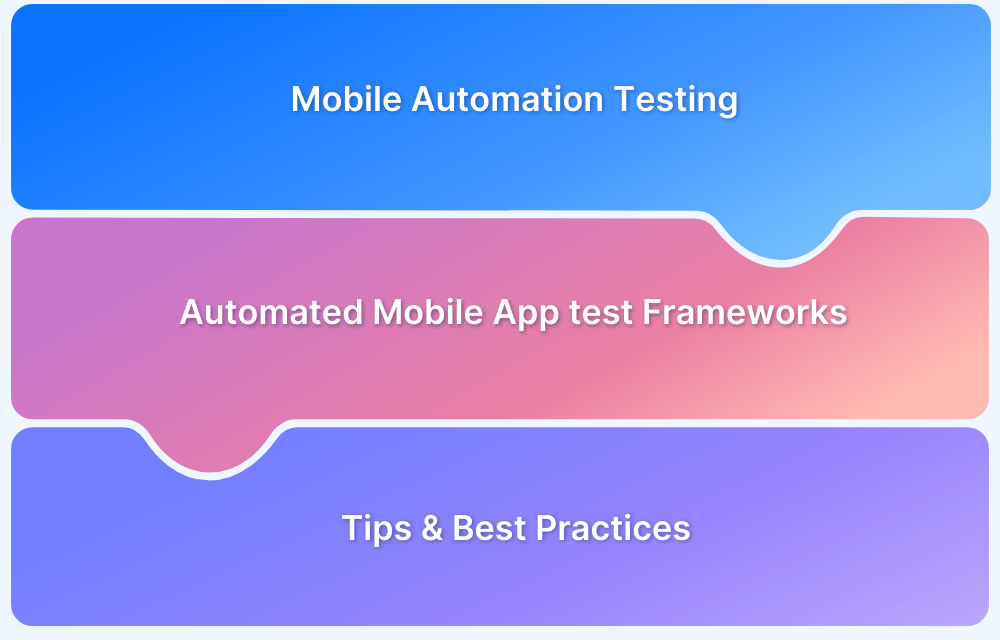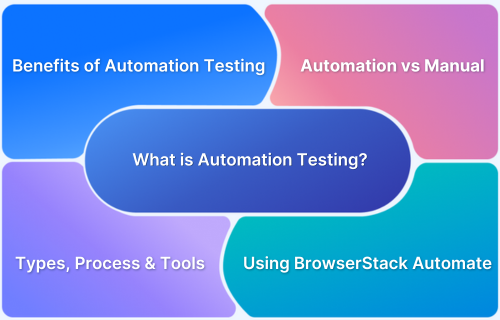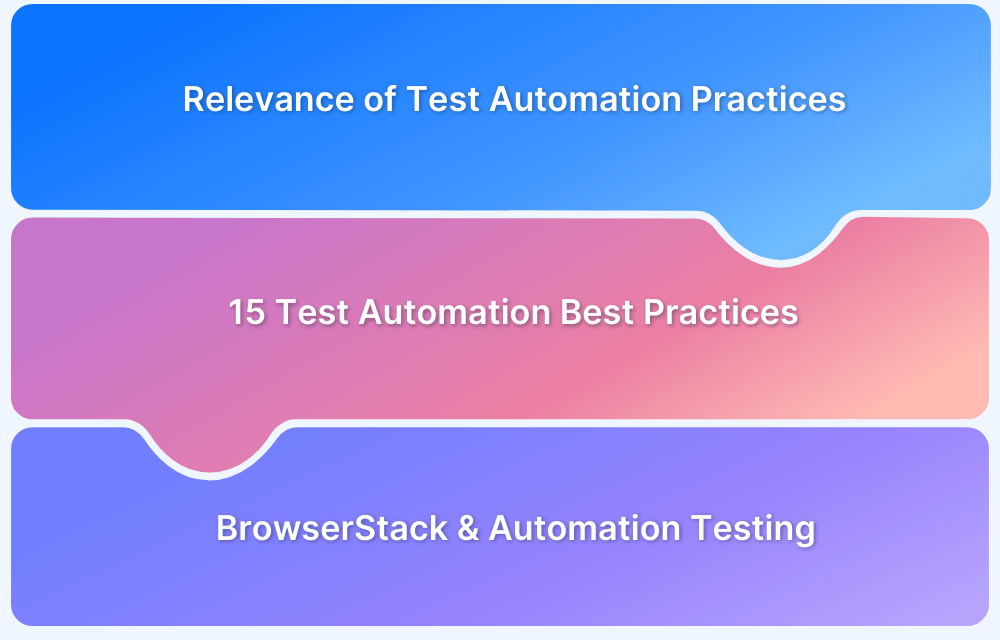As software delivery accelerates, test automation plays a vital role in ensuring quality at scale. However, effective automation requires more than tools. It depends on a strategically structured team with clearly defined roles, relevant expertise, and alignment with organizational objectives.
Overview
What is an Automation Team?
An automation team designs, builds, and maintains automation solutions, focusing on streamlining processes and ensuring smooth, efficient operations across the organisation.
Roles and Responsibilities
- Automation Architects / Solution Designers: Design the automation strategy and architecture to align with business goals and technical needs.
- Business Analysts: Identify automation opportunities by analysing business processes and gathering detailed requirements.
- Project Managers: Oversee automation projects, ensuring timely delivery, budget control, and cross-team coordination.
- Automation Engineers / Developers: Build, test, and maintain automation scripts, tools, and frameworks to streamline testing and operations.
- Support Engineers: Maintain automation solutions post-deployment by troubleshooting issues and ensuring reliability.
- Infrastructure Engineers: Set up, manage, and optimise the infrastructure required to support scalable and secure automation.
- Automation Operations Manager: Manage daily automation workflows, monitor performance, handle incidents, and ensure consistent delivery.
Benefits of Having an Automation Team
- Boosted Efficiency & Productivity: Automation cuts manual work, letting teams focus on strategic tasks.
- Lower Costs & Fewer Errors: Streamlined processes reduce costs and minimise mistakes.
- Better Quality & Insights: Automation improves accuracy and enables smarter decision-making.
- Faster Time to Market: Speeds up development and release cycles.
This article explores the importance of test automation in modern software development, common challenges in building a test automation team, key prerequisites for success, and strategies to address ongoing obstacles.
Importance of Automation in Modern Software Development
Test automation involves using dedicated software tools to automatically run predefined tests on an application. It helps verify that the application behaves as expected, reduces manual effort, and enables faster, more reliable testing.
Test automation is a fundamental part of today’s software development processes. It enables teams to keep up with the speed, scale, and complexity of today’s software demands. Below are the key reasons why automation is vital:
- Faster Release Cycles: Automation significantly reduces the time required to validate new features or changes. By running automated tests after every code commit, teams get immediate feedback, allowing them to detect and fix issues early.
- Broader and Deeper Test Coverage: Manual testing is time-consuming and limited. Automation enables extensive testing across various browsers, devices, and scenarios, ensuring consistent validation of core and edge cases.
Read More: Manual Testing vs Automation Testing
- Improved Accuracy and Reliability: Automated tests execute consistently, eliminating human errors and ensuring defects are reliably detected, especially during regression testing.
- Greater Team Efficiency: Automation handles repetitive tests, freeing QA to focus on exploratory testing and providing developers faster feedback to embed quality early in development.
- Scalability for Growing Applications: Automation supports running large test suites in parallel across multiple environments, maintaining quality as applications become more complex.
- Support for Continuous Integration and Delivery: Automation integrates with CI/CD pipelines to automatically test every build, reducing bugs in production and enabling a steady release pace.
Leveraging a robust platform is crucial to maximizing the benefits of test automation. BrowserStack Automate offers a comprehensive cloud-based solution for running automated tests across a wide range of real devices and browsers, eliminating the need for complex infrastructure setup.
With seamless integration into CI/CD pipelines and scalable parallel testing capabilities, BrowserStack Automate helps teams accelerate delivery while maintaining high-quality standards.
Challenges in Building a Test Automation Team
Creating a test automation team involves various challenges that need to be managed to ensure its efficiency and sustained success.
- Onboarding skilled resources: The design and execution of the framework must be thoroughly understood by the resources used for test automation. The demand for test automation skills is very high, making it difficult to find and onboard such resources.
- Gaps in roles and responsibilities: To enable every team member to excel, it’s essential to recognize their individual strengths and assign tasks that utilize those abilities. When team members are uncertain about their respective roles and responsibilities, they may inadvertently duplicate work on a project or task. Therefore, it’s crucial to define roles and responsibilities clearly to avoid any confusion or overlap.
- Test automation team working in silos: A test automation team frequently operates like its own business within the larger organization, which is one of the reasons it is doomed to failure. All team members must work together for successful test automation because quality is everyone’s responsibility.
- Establish a Key Metric: Before starting automated testing, it is important to clarify its primary purpose. While multiple high-level objectives may break down into smaller, measurable goals, it is essential to pinpoint the single key metric that best represents the core benefit of test automation. The entire team should align with and prioritize this metric to guide their efforts effectively.
Read More: Top 12 AI Automation Testing Tools
Prerequisites to Consider before Building a Test Automation Team
Before assembling a test automation team, several key prerequisites must be evaluated to ensure the team’s success and maximize the effectiveness of automation efforts.
1. Assess the Readiness of Existing Test Artifacts
Before building a test automation team, it is important to evaluate whether existing test cases are comprehensive, well-organized, and suitable for automation.
It is essential to have a test suite that covers the entire application stack with appropriate granularity while avoiding redundant tests across different automation layers, such as unit, API/service, and end-to-end UI tests.
Building a strong, maintainable test suite involves focusing on numerous fast unit tests, supplemented by API tests for integration, and a minimal set of high-level end-to-end UI tests. Additionally, identifying which test cases can be reliably automated is crucial for maximizing efficiency.
Benefits of following this practice:
- Maximum test coverage
- Improved testing efficiency
- Effective test automation execution
2. Clearly Define Team Roles and Responsibilities
Clear identification of roles and duties within the automation team is vital for efficient collaboration and productivity. A balanced team typically includes senior members who are experts in the chosen technology stack and test automation frameworks.
These senior members are responsible for developing robust frameworks, creating test automation strategies and roadmaps, and integrating DevOps best practices.
Junior members focus on writing and maintaining automation scripts. This division of resources helps reduce duplicated effort and fosters skill development while maintaining focus.
Benefits:
- Minimized duplication of effort
- Empowered and focused team members
- Increased operational efficiency
3. Define Test Automation Goals and Select Appropriate Tools and Frameworks
The purpose of automation must be clearly defined before selecting tools, frameworks, or approaches. Important considerations include the type of application (API, web, desktop, mobile), whether automation is for a new or existing project, integration requirements with other systems (test management, bug tracking, CI/CD), execution scale, budget, timelines, and plans for in-sprint automation.
A well-defined goal ensures alignment and helps create realistic delivery schedules that efficiently meet business objectives.
Benefits:
- Improved clarity and planning
- Faster achievement of business goals
- Clear focus and direction
4. Provide Training and Support for Manual QA Engineers Transitioning to Automation
Transitioning manual testers to automation requires structured training and ongoing support. Manual QA professionals need to develop proficiency in the programming languages and frameworks used in the automation process.
Support from development and product teams is essential, as is providing stable APIs and automation-friendly UI elements and encouraging an automation-first mindset. Internal or external training resources should be made available to build the team’s skills effectively, ensuring continuous growth and reducing skill gaps.
Benefits:
- Builds a strong talent pipeline
- Increases employee engagement and retention
- Addresses and prevents skill shortages
Ongoing Challenges and How to Overcome them
Test automation and manual testing complement each other and can coexist effectively within a single, unified QA team. The role of an SDET encompasses much more than just automation, making it unnecessary to maintain a separate automation-only group.
A combined QA team managing both manual and automated testing efforts fosters shared expertise, which is critical to the success of test automation and helps prevent teams from working in silos.
While some QA engineers may prefer to focus exclusively on manual testing, encouraging them to adopt automation can be challenging but ultimately highly rewarding.
A unified team approach can be successful when the following practices are applied:
- Provide your team members with the appropriate training (Internal/External) on the new capabilities, features, trends, etc. that should be part of your framework. By doing so, you can close any technical gaps in your team’s knowledge.
- Develop a coherent test automation strategy.
- Preserve a suitable equilibrium between automated and manual tests.
- Make sure there are regular test scenarios and test script reviews. And take the time for code reviews.
- Pick the right set of test cases for the job and perform regular test automation governance.
- Certify that test cases are properly prioritized to start automation.
- Organise paired code reviews with the development and QA team.
- Push at least a few senior members (Test Architect(s)) from the QA team to dedicate their time to completely focus on the stability of the framework, R&D tasks, adding new capabilities, etc.
- Build automation incrementally and add more tests only when you trust on work done so far. In fact, you can start with simple test cases and then move to complex ones.
- Finally, spread enthusiasm and positivity in the team.
Best Practices for Long-Term Success
Achieving sustained success in test automation requires more than just initial setup; it demands continuous effort, strategic planning, and team collaboration. The following best practices help ensure that the test automation initiative remains effective, scalable, and aligned with evolving business needs:
- Establish Clear Goals and Metrics: Define measurable objectives and key performance indicators (KPIs) to track the impact of test automation. Clear goals help maintain focus and allow the team to evaluate progress, optimize processes, and demonstrate value to stakeholders.
- Foster Collaboration Across Teams: Encourage close cooperation between QA, development, and product teams to align priorities, share knowledge, and streamline workflows. This collaboration ensures that automation efforts reflect real-world use cases and integrate smoothly into development pipelines.
- Invest in Training and Skill Development: Staying current with new tools, frameworks, and industry best practices is crucial. Offer frequent training sessions and opportunities for team members to improve their technical abilities and expand their knowledge of automation techniques.
- Maintain a Robust and Maintainable Test Suite: Focus on building a test suite that is reliable, modular, and easy to maintain. Regularly review and refactor automated tests to eliminate flaky tests, reduce redundancy, and ensure fast execution times.
- Integrate Automation into CI/CD Pipelines: Embed automated testing within continuous integration and delivery workflows to enable rapid feedback and faster releases. This integration supports early defect detection and helps maintain high-quality standards throughout the development cycle.
- Prioritize Test Coverage and ROI: Balance test coverage with the cost and effort of automation. Focus automation on high-value areas such as critical functionalities, frequently used features, and regression testing, while avoiding over-automation of low-impact scenarios.
- Monitor and Adapt: Continuously monitor automation outcomes and solicit feedback to identify bottlenecks or areas for improvement. Stay adaptable to changes in the application, technology stack, and business requirements to keep the automation framework relevant.
Why Choose BrowserStack for Test Automation
BrowserStack offers a robust cloud-based platform designed to streamline and scale test automation efforts, making it an ideal solution for automation teams seeking efficiency and reliability.
Here’s why it’s a preferred choice for teams aiming for efficient and reliable testing:
- Extensive Device and Browser Access: Instant testing on 3500+ real devices and browsers without hardware setup
- Seamless CI/CD Integration: Works smoothly with popular tools like Jenkins, Travis CI, and Bamboo for automated workflows
- Powerful Debugging Tools: Detailed logs, screenshots, and video recordings help quickly identify and fix issues
- Scalable Parallel Testing: Run multiple tests simultaneously to speed up testing and increase coverage
- Supports Major Frameworks: Compatible with Selenium, Appium, Cypress, Playwright, and more
- Secure Testing Environment: Protects sensitive data and supports testing on private apps via BrowserStack Local
Conclusion
Building a successful test automation team requires clear goals, the right skill sets, and effective collaboration. Careful planning of team structure, tool selection, and ongoing training ensures that automation efforts deliver maximum value. Embracing best practices such as unified QA teams and continuous learning fosters long-term success.
Leveraging powerful platforms like BrowserStack further empowers teams to scale testing efficiently across diverse environments, accelerating release cycles while maintaining high software quality. With the right foundation and tools in place, organizations can confidently meet the growing demands of modern software development.






